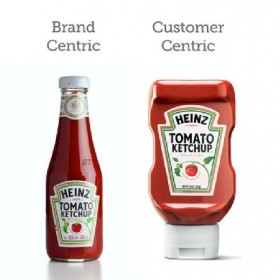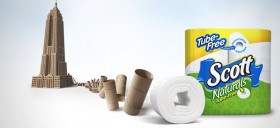I never knew toilet paper could be exciting until I met Dave.
Dave joined me in the Veryfine Marketing Research Department in the early days of 1993 after a two-year stint at James River, maker of Quilted Northern bathroom tissue. He entertained us with stories of the brand’s relaunch the year before. Segmentation studies had characterized different types of toilet-tissue users. Press releases detailing the segments had persuaded radio personalities to talk about the product.
Clearly James River employees and their marketing agencies had both great creativity and a good sense of humor.
You need creativity and humor to market a commodity like toilet paper. While technological products rely on new introductions and updates for their marketing communications, mundane products like toilet paper struggle to gain attention.
Hence the reason Mr. Whipple held onto his job for so long.
Until three weeks ago, the most recent innovations in the toilet paper category were three-ply (2008), two-ply (1942) and splinter-free (1935).
Yes, you read that right. Splinter-free. And that’s all I have to say about that.
Three weeks ago Kimberly-Clark announced that its Scott Paper brand was launching a tubeless toilet paper nationwide. The tubeless rolls have been in test in New York, New Jersey and Pennsylvania for four years. Apparently they are ready for prime-time!
Consumers’ desire to go green but not pay more for environmentally conscious products was the impetus for the product redesign, according to Scott Paper brand manager Jared Mackrory.
Though initial reviews seem mixed, I applaud Kimberly-Clark. I predict their attempt to stem the 17 billion paper tubes that are discarded yearly will earn them goodwill among consumers and that the product will catch on or spur further innovation.
Innovation is necessary for brands to evolve and stay relevant. Done well, it can establish or reinforce a brand as a category leader.
Inspiration for innovation can come from surprising places.
Lore has it that Dr. Washington Sheffield, a dentist practicing in New London, CT, began putting his Crème Dentrifice in tubes rather than jars after his son saw artists squeezing paint from tubes in Paris. Prior to that innovation, household members dipped their toothbrushes into one communal jar of the crème. Artistic inspiration led to less mess and improved hygiene.
What do the Scott Paper and Crème Dentrifice innovations have in common? Besides that they both involve tubes?
They both solved consumer problems.
Brands that continually seek new ways to solve consumer problems will thrive. Even if the problem they solve is one they created.
 The image at left depicting the different mindsets represented by the two Heinz bottles has been circulating in social media for a while. The ketchup leader, who in the 1970s made an entire ad campaign out of the wait required for the ketchup to flow through the glass bottle neck, addressed the issue of expediting the product in 2002.
The image at left depicting the different mindsets represented by the two Heinz bottles has been circulating in social media for a while. The ketchup leader, who in the 1970s made an entire ad campaign out of the wait required for the ketchup to flow through the glass bottle neck, addressed the issue of expediting the product in 2002.
Many brands spring from enterpreneurs’ own frustrations.
In 2010, four Wharton students launched Warby Parker to provide designer eyeglasses at reasonable prices after one of the students spent a semester squinting because he couldn’t afford to replace the pair he lost. They also launched a “Buy One, Give One” program so that each purchase results in a pair of glasses donated to someone in need.
Innovation launches brands, evolves brands and can help Brands in Adolescence find their next area of growth.
To identify innovation opportunities for your brand:
- Look to solve a problem directly related or adjacent to your offering. Listen to consumers’ feedback and observe them using your product. Focus on the user experience from start to finish by trying it yourself.
- Pay attention to trends and advances in other product and service categories.
- Track attitudinal changes that may affect your offering and make adjustments that your constituents support.
- Explore ways to facilitate or add excitement to the product delivery.
Find your brand’s way to go tubeless. Discover new opportunities to deepen its relationship with its customers and to grow.
Now if they could only invent a self-replacing roll!
If you liked this post, you’ll love the next one.
To have future posts sent to your inbox...

